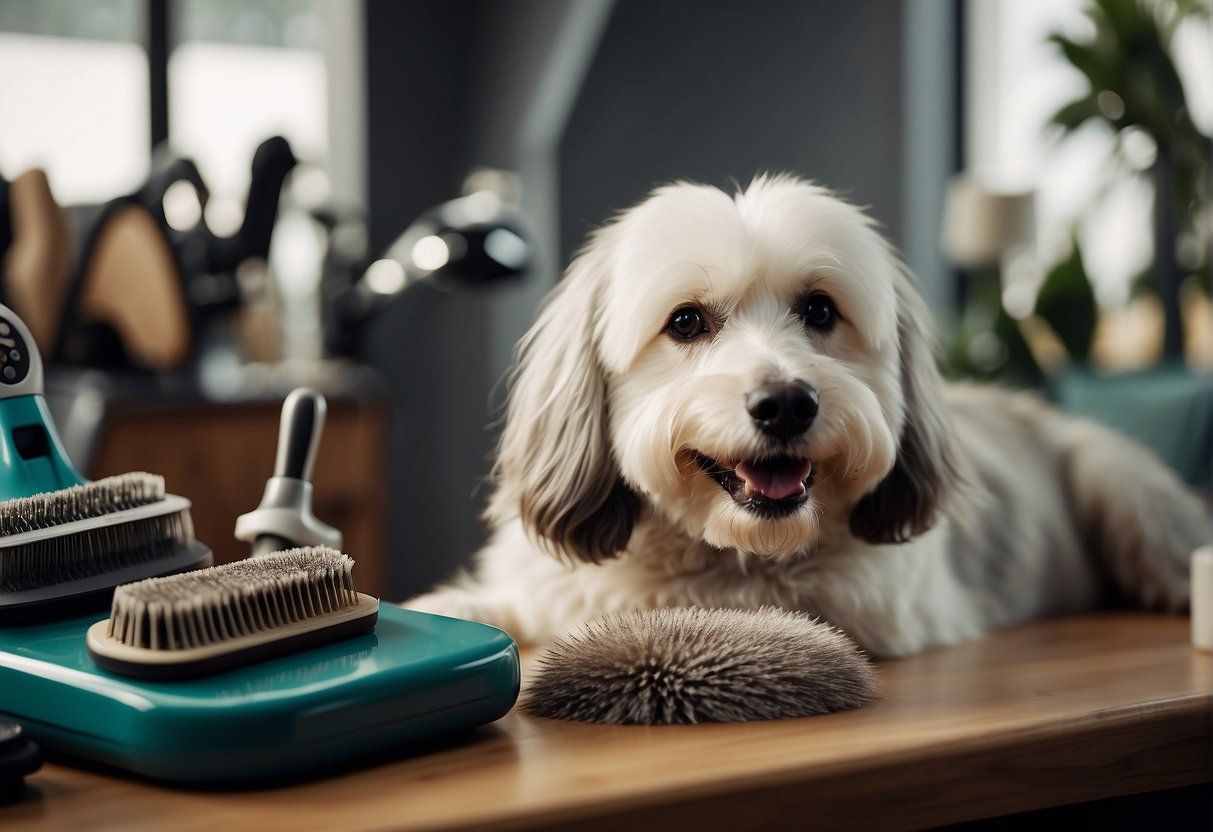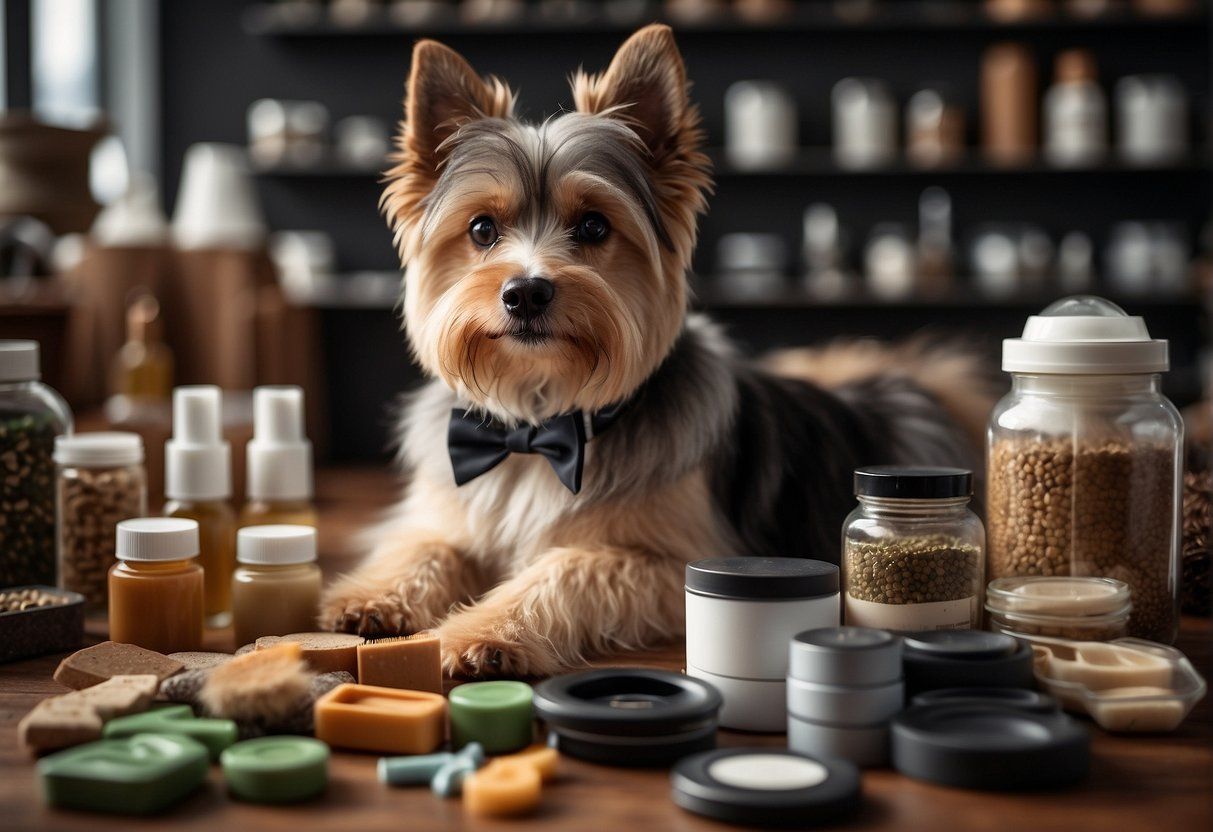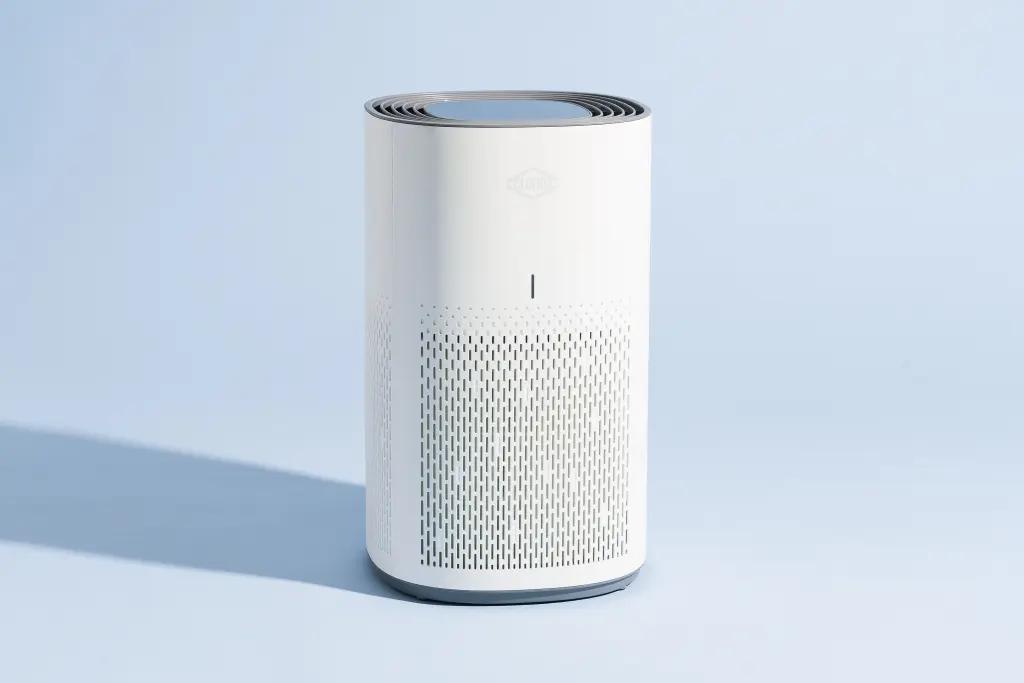10 Tips To Control Dog Shedding - Full Guide
10 Tips To Control Dog Shedding - Full Guide

Vet Reviewed

By: Sarah Hodgson
February 15, 2024
- Posted in Dogs
Table of Contents
Dog shedding can be a frustrating problem for dog owners, especially those who suffer from allergies or have a lot of furniture to clean. While shedding is a natural process for dogs, there are ways to control it. In this article, we will provide 10 tips to help you manage your dog's shedding and keep your home clean.
Let's dive in!
What Exactly Is Dog Shedding?
Before we dive into the ways to control the shedding, let's get a better idea of how it works and what exactly dog shedding is.
Dog shedding is a natural process where dogs lose their old or damaged hair to make way for new growth. While shedding is a normal occurrence, excessive shedding can be a nuisance for dog owners.
The Science of Hair Growth
Hair growth in dogs occurs in cycles, with three phases: anagen, catagen, and telogen. During the anagen phase, the hair follicle is active and hair grows. The catagen phase is a transitional phase where the follicle shrinks and hair growth slows down. Finally, during the telogen phase, the hair follicle is at rest, and old hair falls out to make way for new hair growth.
Common Factors Affecting Shedding
Several factors can affect shedding in dogs. The main factors being:
- Genetics
- Nutrition
- Stress
Dogs with double-coats, such as Huskies and Golden Retrievers, shed more than dogs with single coats. Nutrition also plays a role in shedding, with poor nutrition leading to dull, dry coats and increased shedding. Stress can also cause excessive shedding, as stress hormones can disrupt the hair growth cycle.
10 Tips To Control Shedding
Dog shedding is a natural process that can be managed with proper nutrition, grooming, and stress management. Understanding the science behind hair growth and common factors affecting shedding can help pet owners control shedding in their dogs.
1. Brushing

Brushing is one of the most effective ways to control dog shedding. Regular brushing removes loose and dead hair from the dog's coat, preventing it from falling off around the house. It also helps distribute natural oils throughout the coat, keeping it healthy and shiny.
Different breeds require different types of brushes. For example, a slicker brush is ideal for dogs with long hair, while a rubber brush works best for short-haired breeds. It's important to choose the right brush for your dog's coat to get the best results.
- To brush your dog effectively, start at the head and work your way down to the tail. Use long, gentle strokes, and be sure to brush in the direction of hair growth. Pay extra attention to areas where shedding is most noticeable, such as the back and sides.
- Brushing should be done at least once a week, but some breeds may require daily brushing. It's also important to clean the brush regularly to remove any trapped hair and dirt.
2. A Healthy Diet
A healthy diet is essential for a dog's overall well-being and can also help to control shedding. Feeding your dog a balanced and nutritious diet can improve their skin and coat health, which in turn can reduce shedding.
When selecting a dog food, look for high-quality protein sources, such as chicken, beef, or fish. These proteins provide the building blocks for strong and healthy hair follicles. Additionally, look for foods that contain omega-3 and omega-6 fatty acids, which can help to reduce inflammation and improve skin and coat health.
- It's also important to avoid feeding your dog table scraps or low-quality dog food, which can be high in fillers and additives that provide little nutritional value. These low-quality foods can contribute to poor skin and coat health, which can lead to excessive shedding.
- In addition to providing a healthy diet, make sure your dog has access to plenty of fresh water. Dehydration can lead to dry skin, which can exacerbate shedding. Consider adding a water fountain to your home to encourage your dog to drink more water.
3. Supplements to Reduce Shedding

Supplements can help reduce shedding in dogs by promoting healthy skin and coat. Here are a few supplements that can be added to a dog's diet to help control shedding:
- Omega-3 Fatty Acids: Omega-3 fatty acids are essential for healthy skin and coat. They can help reduce inflammation and improve skin moisture, which can reduce shedding. Fish oil supplements are a good source of omega-3 fatty acids for dogs.
- Biotin: Biotin is a B-vitamin that is important for healthy skin and coat. It can help reduce shedding and improve coat quality. Biotin supplements can be added to a dog's diet to provide additional support.
- Probiotics: Probiotics can help improve the overall health of a dog's skin and coat. They can help improve digestion and nutrient absorption, which can lead to healthier skin and a reduced amount of shedding. Probiotic supplements can be added to a dog's diet to help promote a healthy gut.
Note
It's important to note that supplements should not be used as a substitute for a healthy diet. A balanced diet that includes high-quality protein, healthy fats, and essential vitamins and minerals is essential for a dog's overall health and well-being. Always consult with a veterinarian before adding any supplements to a dog's diet, as some supplements may interact with medications or have unwanted side effects.
4. Keeping Hydrated
Hydration is essential for a dog's overall health, and it can also help control shedding. When a dog is dehydrated, their skin becomes dry and flaky, which can lead to excessive shedding. Therefore, it's crucial to ensure that your dog is drinking enough water throughout the day.
- One way to encourage your dog to drink more water is to provide them with fresh, clean water at all times. It's also a good idea to have multiple water sources available, such as a water bowl in the kitchen and one in the living room. Additionally, some dogs prefer running water, so a pet fountain may be a good investment.
- Another way to keep your dog hydrated is to feed them a high-quality, moisture-rich diet. Wet food or adding water to dry kibble can help increase your dog's overall water intake, which can lead to healthier skin and coat.
It's important to note that while water is essential for a dog's health, too much water can also be harmful. Overhydration can lead to water intoxication, which can be fatal. Therefore, it's important to monitor your dog's water intake and ensure that they are not drinking excessive amounts of water.
5. Bathe Your Dog
Regular bathing can help control dog shedding. Bathing your dog removes dirt and loose hair from their coat, which can help reduce shedding. However, excessive bathing can strip the natural oils from your dog's skin and coat, leading to dryness and irritation. Therefore, it is important to bathe your dog only when necessary.
When bathing your dog, use a mild shampoo that is specifically formulated for dogs. Human shampoos can be too harsh for your dog's skin and coat. Before bathing your dog, brush their coat to remove any loose hair and mats. This will make the bathing process easier and more effective.
After shampooing, rinse your dog thoroughly with warm water to remove all the shampoo. Leftover shampoo can cause skin irritation and dryness. Use a towel to dry your dog's coat, and avoid using a blow dryer, as the heat can damage their skin and coat.
6. Air Purifiers

Air purifiers are a great way to reduce the amount of pet hair and dander in the air. They work by filtering out the particles that cause allergies and other respiratory problems. There are many different types of air purifiers on the market, so it's important to do your research before purchasing one.
When looking for an air purifier, consider the size of the room it will be used in. A small air purifier may be sufficient for a bedroom, but a larger one may be needed for a living room or other common area. It's also important to consider the type of filter used in the air purifier. HEPA filters are the most effective at removing pet hair and dander from the air.
In addition to reducing pet hair and dander, air purifiers can also help to eliminate odors caused by pets. Some air purifiers come with additional features such as ionizers or UV-C lights, which can help to further purify the air.
7. Vacuuming
Vacuuming is an essential part of controlling dog shedding. It helps to remove loose fur, dirt, and dander from your floors and furniture. Here are some tips for effective vacuuming:
- Use a high-quality vacuum cleaner with a HEPA filter to trap allergens and fine particles.
- Vacuum at least once a week, more often if you have a heavy shedder.
- Use attachments to clean hard-to-reach areas like corners, baseboards, and upholstery.
- Use a rubber brush attachment to loosen and remove hair from carpets and furniture.
- Empty the vacuum canister or replace the bag frequently to maintain suction power.
Regular vacuuming can significantly reduce the amount of fur and dander in your home, making it more comfortable for both you and your furry friend. It can also help to prevent allergies and respiratory problems caused by pet hair.
8. Keeping a Cleaner Home
Dog shedding can be a messy affair, but there are several ways to keep your home cleaner despite the shedding. Here are some tips to help you maintain a cleaner home:
- Vacuum frequently: Regular vacuuming can help to reduce the amount of dog hair and dander in your home. Use a vacuum cleaner with a HEPA filter to trap even the smallest particles.
- Use a lint roller: Keep a lint roller handy to quickly remove dog hair from your clothes and furniture. This is especially useful for removing hair from upholstered furniture and car seats.
- Wash bedding regularly: Your dog's bedding can be a major source of shedding. Wash it at least once a week to keep it clean and reduce the amount of hair in your home.
- Use washable covers: Consider using washable covers for your furniture and car seats. This will make it easier to remove hair and keep your home clean.
- Groom your dog regularly: Regular grooming can help to reduce shedding. Brush your dog's coat at least once a week and bathe them every few months to keep their coat healthy and shiny.
- Keep your dog off the furniture: If possible, train your dog to stay off the furniture. This will help to reduce the amount of hair on your upholstery.
- Use air purifiers: Air purifiers can help to remove pet hair and dander from the air in your home. Look for a purifier with a HEPA filter for the best results.
- Clean up messes quickly: If your dog has an accident or spills food or water, clean it up immediately. This will help to prevent stains and odors from setting in.
By following these tips, you can keep your home cleaner and more comfortable for both you and your furry friend.
9. Allergic Reaction
For some people, dog shedding can cause an allergic reaction. This reaction is caused by the protein found in a dog's dander, urine, and saliva. Symptoms can include sneezing, runny nose, itchy eyes, and skin rashes.
To minimize allergic reactions, it is important to keep the home clean and free of dog hair. Regular vacuuming and dusting can help remove loose hair and dander from surfaces. Additionally, washing the dog's bedding and toys regularly can help reduce the amount of allergens in the home.
It is also important to consider the breed of dog when selecting a pet. Some breeds are known to shed less and produce fewer allergens. Breeds such as Poodles, Bichon Frises, and Portuguese Water Dogs are often recommended for people with allergies.
If allergies are severe, it may be necessary to consult with an allergist or consider alternative pet options such as fish or reptiles. Overall, managing allergies caused by dog shedding requires a combination of cleaning, breed selection, and potentially medical intervention.
10. When to Consult a Veterinarian
While shedding is a normal process for dogs, excessive shedding can be a sign of an underlying health issue. If you've tried all the tips and tricks to control your dog's shedding but still notice excessive hair loss, it's time to consult a veterinarian.
Here are some signs that indicate you should take your furry friend to the vet:
- Bald patches: If you notice bald patches on your dog's coat, it could be a sign of a skin condition or an infection. A veterinarian can diagnose the underlying issue and provide appropriate treatment.
- Excessive itching: If your dog is scratching excessively, it could be a sign of allergies or parasites. A veterinarian can help identify the cause and provide medication to alleviate the itching.
- Changes in behavior: If your dog is shedding more than usual and also showing signs of lethargy, loss of appetite, or other behavioral changes, it could be a sign of an underlying health issue. A veterinarian can perform a physical exam and recommend further tests if necessary.
Note
Remember, a healthy dog has a shiny coat and sheds only moderately. If you notice excessive shedding or any other signs of discomfort, take your furry friend to the vet for a checkup.
Investing in Specialized Shedding Tools

Investing in specialized shedding tools can help control dog shedding and make the process easier for both the dog and the owner. Here are some tools that can be useful:
- Furminator: This tool is designed to remove loose fur from the undercoat without damaging the topcoat. It is available in various sizes for different breeds and coat types.
- Slicker brush: This brush has fine, short wires close together that can remove loose fur and tangles. It is suitable for most coat types.
- Rubber curry brush: This brush has rubber teeth that can remove loose fur and dirt. It is suitable for short-haired breeds.
- Shedding blade: This tool has a serrated edge that can remove loose fur and dirt. It is suitable for medium to long-haired breeds.
Using these tools regularly can help reduce shedding and keep the coat healthy. It is important to use them gently and not overdo it, as excessive brushing can irritate the skin and cause more shedding.
Choosing the Right Dog Breed
When it comes to controlling dog shedding, choosing the right breed can make a big difference. Some breeds are more prone to shedding than others, and some have coats that require more maintenance than others. Here are some things to consider when choosing a breed:
Hypoallergenic Dogs
For those with allergies, hypoallergenic dogs can be a great option. These breeds produce less dander, which is the primary cause of allergic reactions. Poodles are a popular hypoallergenic breed, as they have hair instead of fur and shed very little. Other hypoallergenic breeds include the Bichon Frise, Maltese, and Portuguese Water Dog.
Breeds Prone to Minimal Shedding
Some breeds are known for shedding very little, making them a good choice for those who want a dog but don't want to deal with excessive shedding. The Chinese Crested is a hairless breed that doesn't shed at all, while the Basenji and Whippet have short, fine coats that require minimal grooming. The Greyhound is another breed that is known for minimal shedding.
Overall, choosing the right breed can go a long way in controlling dog shedding. By considering factors like hypoallergenic breeds, minimal shedding breeds, and double-coated breeds, you can find a dog that fits your lifestyle and shedding tolerance.
The Bottom Line
So there you have it, controlling dog shedding requires a combination of proper grooming, nutrition, and regular visits to the vet. By following these tips, dog owners can create a comfortable, healthy, and beautiful living space for themselves and their furry friends. So get that brush out and start controlling their shedding.

Subscribe to Petfluence!
Get updates on the latest posts and more from Petfluence straight to your inbox.